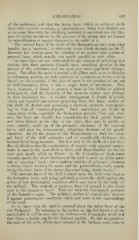Page 589 - My FlipBook
P. 589
AMELIFICATIOK 599 ;
of the epidermis, and that the horny layer which in ordinary shells
forms this external envelope, or ' periosti'acum,' being here thrown out
at the same time with the ealcifvino; material, is converted into the like-
ness of cellular membrane by the pressure of the prisms that are formed
by crystallization at regular distances in the midst of it.
" The internal layer of the shells of the Margaritacese and some other
families has a ' nacreous,' or iridescent, lustre Avhich depends (as Sir D.
Brewster has shown) upon the striation of its surface with a series of
grooved lines, which usually run nearly parallel to each other.
" As these lines are not obliterated by any amount of polishing, it is
obvious that their presence depends upon something peculiar in the
texture of this substance, and not upon any mere superficial arrange-
ment. But when the nacre is treated with dilute acid, so as to dissolv'e
its calcareous portion, no such repetition of membranous layers is to be
found ; on the contrary, if the piece of nacre be the product of one act
of shell-formation, there is but a single layer of membrane. This
layer, however, is found to present a more or less folded or plaited
arrangement, and the lineation of the nacreous surface may perhaps
be thus accounted for. A similar arrangement is found in pearls,
which are rounded concretions projecting from the inner surface of
the shells of Avicula and possessing a nacreous structure correspond-
ing to that of ' mother-of-pearl.' Such concretions are found in
many other shells, especially the fresh-water mussels, Unio and Ano-
don, but these are usually less remarkable for their pearly lustre
and when formed at the edge of the valve, they may be partly, or
even entirely, made up of the prismatic substance of the external
layer, and may be, consequently, altogether destitute of the pearlv
character. In all the genera of the Margaritacese we find the exter-
nal layer of the shell prismatic and of considerable thickness, the
internal layer being nacreous. But it is only in the shells of a few fam-
ilies of bivalves that the combination of organic Avith mineral compo-
nents is seen in the same distinct form, and these families are for the
most part nearly allied to Pinna. In the Unionidse (or fresh-water
mussels) nearly the whole thickness of the shell is made up of the inter-
nal, or ' nacreous,' layer ; but a uniform stratum of prismatic substance
is always found between the nacre and the periostracum, really consti-
tuting the inner layer of the latter, the outer being simply horny."
The nacreous layer of the shell is found upon the inner side, next to
the formative layer, and, being polished, protects the shell against the
action of any pathological condition which may occur in the body of
the mollusk. The cortical, or nacreous, layer of enamel is also found
next to the formative layer. They are both the last-formed products
of the formative organ. The polished surface of enamel also protects
it against pathological conditions which may arise in the surroundings
of the tooth.
As we have seen, the shell is secreted above the infant layer of the
rete Malpighii. By referring to the section on the development of the
ameloblasts it will be seen that the bulbous cord iuA-aginates itself, and
thus forms a double cap for the dentinal papilla. By this invagination
the ends of the cells, which were external in the bulbous cord, come in


